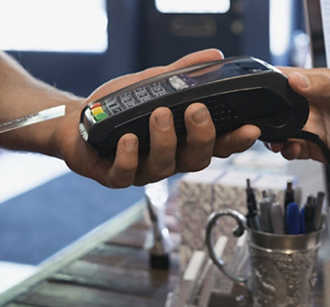
How Does a Debit Card Work?
While credit cards and debit cards look similar, the key difference is where the funds originate:
- With a credit card payment, the account number on the card is tied to a line of credit offered to the customer’s card-issuing bank. The bank, in turn, provides the funds to pay the merchant.
- With a debit card payment, the account number is linked directly to the cardholder’s bank account. The full amount or the purchase is immediately deducted from his or her account balance. (Issuing bank must confirm the cardholder has available funds to complete the transaction.)
Debit Card History: Three Major Milestones
Debit cards have evolved dramatically over the years – spurred by consumer demand and technological improvements. Below are three significant milestones throughout debit card history.
1966: The Bank of Delaware launches a debit card pilot program as an alternative to carrying cash or a checkbook. Adoption of this new debit card system is slow because there’s no technology connecting merchants to banks outside their state.1
1969: The first Automatic Teller Machine (ATM) in the U.S. makes its appearance at Chemical Bank in Rockville, New York. Consumers are able to withdraw cash using a form and a PIN number. Debit cards made the process more user-friendly in the 1970s.2
2017: Approximately 66 percent of American consumers say they prefer making debit card payments over credit cards because they give them more control over their finances by preventing overspending and interest charges.3
Different Types of Debit Cards
Like credit cards, most debit cards come with:
- Imprinted account numbers (for online transactions)
- Magnetic stripes (for legacy card terminals)
They are also programmed with Personal Identification Numbers (PINs) to protect customers, merchants, and banks from fraudulent debit card payments.
However, many newer types of debit cards come with additional fraud prevention technology to help keep users safe:
- Most debit cards are now issued with embedded security chips that help reduce the risk of fraudulent transactions. Instead of swiping these types of debit cards, consumers dip their plastic into chip readers (Click here to learn more about EMV).
- There are also contactless debit cards that leverage Near Field Communication (NFC) technology. With this payment option, the plastic never touches the reader. Instead, users wave their contactless debit cards close to the NFC terminal to initiate transactions
The Mechanics of Accepting Debit Card Payments
The Debit Transaction Process
Payments made with debit cards are processed the same way as those made with credit cards. The only difference is that once the transaction is identified as a debit payment (either by the POS system or the customer), the cardholder is prompted to enter his or her PIN.
After authenticating the PIN, the payment is routed to a debit network, such as First Data’s STAR, Pulse, NYCE, or SHAZAM, which handles:
- Authorizing
- Clearing
- Settlement
Some debit cards are also attached to a credit card network to enable signature debit transactions. These can be processed as either debit or credit:
- Depending on the POS system used, the merchant or the cardholder gets to choose
- If credit is selected, the transaction will be routed through the associated credit network and will require a signature for authentication rather than a PIN
Adding a Debit Card System to Your Payment Environment
Although there are differences between how credit and debit cards work, you don’t need to configure your payment environment for one or the other. If you currently accept credit card payments, you’re already set up for debit cards.
However, there are steps you can take to:
- Decrease costs
- Reduce fraud
- Increase sales
That’s where our PCI-compliant payment solutions can help. To learn more about our approach to secure credit and debit card processing, contact us today.
Source
1 ”A Guide to the ATM and Debit Card Industry,” Federal Reserve Bank of Kansas City, 2003
2 ”The ATM at 50: It Was Invented before the Debit Card (and Other Weird Facts),” MarketWatch, 28 June 2017
3 ”Here are the only 3 times you should use a debit card,” CNBC, 17 October 2017




